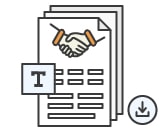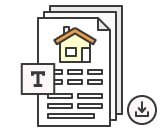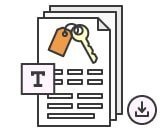Rent-to-Own Agreement

A Rent-To-Own Agreement is an agreement between a landlord (lessor) and a tenant (lessee) to rent a property with the option to purchase before the lease agreement expires. It contains a standard lease agreement, plus terms whereby the tenant can exercise an option to purchase the property.
Pros and Cons of a Rent-To-Own Agreement
A Rent-To-Own Agreement can benefit both an owner and a tenant-purchaser, but it also comes with some unique risks and drawbacks. These are some of the advantages:
Pros of a Rent-To-Own Agreement
- Adapts To Market Conditions – In a tough seller’s market, a Rent-To-Own Agreement may entice buyers who are not quite ready to purchase a home but are planning to soon.
- Lowers Costs – A Rent-To-Own Agreement can line up a potential property sale without having to hire a real estate agent or otherwise specially market the property.
- Boosts Income – An occupied home lets a landlord enjoy a steady income rather than letting a property go empty while it’s on the market for sale. Additionally, if the tenant decides not to exercise the purchase option, the landlord can keep the option fee and any rent credit provided by the tenant.
- Confers Tax Advantages – Depending on the property owner’s cashflow, there may be much lower overall tax rates for a steady stream of rental income rather than a lump sum from a property sale.
- Helps Resolve Finance Issues – Sometimes a tenant wants to buy a home but has difficulty qualifying for a mortgage due to credit score, down payment amount, or other reasons. A Rent-To-Own Agreement gives the tenant time to get finances in order, while still locking in an option to buy a home.
- Enables Flexibility – If a tenant is unwilling or unable to go through with a purchase at the end of the rental term, they can decline the option and end the lease just like any other lease agreement.
- Provides Equity – A Rent-To-Own Agreement lets tenants build equity in a house before owning it via the option fee and any rent credit. Depending on the terms, the tenant might even be able to build equity by improving the property through maintenance and repairs.
Cons of a Rent-To-Own Agreement
While there are many good reasons to enter into a Rent-To-Own Agreement, there are also some disadvantages compared with a regular lease. These include:
- Limits Owner Options – Once a landlord commits to a Rent-To-Own Agreement, they cannot refuse to honor the purchase option or sell the property to another individual. A fixed purchase price likewise locks the owner in if the property’s market value balloons unexpectedly.
- Risks Market Reversals – A set purchase price may frustrate a landlord if the property’s market value increases significantly over time. Conversely, if the property’s value falls, the tenant might decline the purchase option and walk away, forcing the owner to sell to other buyers at a lower price.
- Amplifies Any Tenant Misconduct – Unlike a traditional lease agreement, tenants are often responsible for some or all maintenance and repairs during the lease term. If such tenants neglect the property and then decline the purchase option, the landlord will have to foot a hefty repair bill or file an expensive lawsuit.
- Risks Tenant Financial Loss – Tenants risk more money under a Rent-To-Own Agreement than they do under a regular lease. If they can’t go forward with the purchase option, they usually lose both their option fee and any portion of rent credited toward the purchase.
- Adds Potential Loss of Option – Some Rent-To-Own Agreements have strict conditions for exercise of the purchase option. Tenants might lose their option through circumstances beyond their control. A late notification or delayed rent payment might result in loss of the option fee, rent credit, and cost of property improvements.
- Increases Dependency on Landlord Finances – A Rent-To-Own Agreement makes a tenant more reliant on the landlord’s good administration than would be the case in a normal lease. A landlord who’s irresponsible in paying a property’s mortgage, taxes, and other obligations might end up with a lien or foreclosure which blocks the tenant’s purchase option.
Additional Considerations
The unique nature of a Rent-To-Own Agreement creates some additional considerations for both the landlord and tenant:
- Complexity – A Rent-To-Own Agreement adds complexity over a regular lease, since it involves the potential sale of real estate. It involves conceptions like options, rent credit, and lease-option versus lease-purchase, none of which appear in ordinary rental situations.
- Due Diligence – Tenants under a Rent-To-Own Agreement must take much greater care inspecting the property’s condition and history than they would under an ordinary lease. There’s usually at least a formal inspection, check of property tax status, and appraisal involved before purchase.
- Disclosures – Different states require varying levels of disclosure regarding the condition of a property that’s optioned for purchase. Required disclosures are a critical consideration in a Rent-To-Own Agreement.
Lease-Option and Lease-Purchase
There are two types of rent-to-own arrangements: lease-option agreements , and lease-purchase agreements .
A lease-option agreement works mostly the same as a regular lease, but provides the tenant with an option to purchase the property at the end of the lease term. The tenant freely chooses whether to buy the property or walk away.
A lease-purchase agreement, by contrast, is an agreement to buy the property at the end of the lease term. If the tenant is allowed to break the agreement, there’s usually a penalty for doing so.
What To Include in a Rent-To-Own Agreement
A Rent-To-Own Agreement mostly has terms similar to those in a standard lease agreement. There are some important additions and differences:
- Option To Purchase – Unlike a regular lease, a Rent-To-Own Agreement contains terms that allow the tenant an option to purchase the property.
- Terminology – Since a Rent-To-Own Agreement is still a lease at base, there is still a landlord and tenant. However, the tenant is also considered the property’s “buyer” and the landlord, in most cases, is also the “owner.”
- Rent Payments – Rent-To-Own Agreements usually have a higher monthly rent than the current market rate. This covers the “rent credit,” which is a portion of the rent set aside in escrow which the tenant can later use toward the purchase price of the property.
- Option Fee – A Rent-To-Own Agreement typically demands a nonrefundable upfront “option fee” upon execution. This option fee gets applied to the purchase price when the tenant exercises the purchase option. The option fee can vary but usually is up approximately 1-5% of the purchase price.
- Property Maintenance – Maintenance usually is the landlord’s responsibility, but depending on state law , many Rent-To-Own Agreements may pass some or all of these duties to the tenant. This makes a thorough inspection before the start date of the lease (ideally with a Move-In Checklist ) especially important.
Essential Terms and Conditions for a Rent-To-Own Agreement
The following terms and conditions are essential when drafting a Rent-To-Own Agreement:
- Lease Terms – The duration of the rental.
- Payments – Include all payments and potential fees required from the tenant, plus due dates and accepted means of payment.
- Option Terms – This includes the period in which a tenant can exercise an option to purchase the property. Typically specifies a purchase price (and/or how it’s calculated), and also includes the steps a tenant must take to exercise the purchase option.
- Signatures – Signatures from both the landlord and tenant grant the agreement legal effect according to the terms agreed.
Additional Items To Include with a Rent-To-Own Agreement
Some rentals require additional disclosures and addendums, depending on jurisdiction and specifics of the property. These are some additional items an agreement may have to incorporate:
- Lead-Based Paint Disclosure
- Asbestos Disclosure
- Bed Bug Addendum
- Pet Addendum
- Carbon Monoxide and Smoke Detector Addendum
- Flood Zone Disclosure
- Mold Disclosure
- Shared Utilities Disclosure
- Move In Inspection Checklist
- Move Out Checklist
When the Rent-To-Own Agreement isn’t drafted as a single unitary document, many drafters include a separate cover page listing the disclosures and addendums that are part of the agreement. This helps avoid confusion as to which additional documents are incorporated as part of the agreement.
Final Considerations
- Key Terms – A Rent-To-Own Agreement may contain unfamiliar legal terms and concepts. If there’s any lack of clarity on proposed terms, it’s critical to get an attorney’s review. Contracts operate by default on a “caveat emptor” (“may the buyer beware”) policy; ignorance is not a defense for signing an unfavorable contract.
- Signed Copy – The landlord, and all tenants, should keep a signed copy of the Rent-To-Own Agreement, together with a copy of any addendum or supporting information.
After Signing a Rent-To-Own Agreement
For the most part, a Rent-To-Own Agreement works like a normal lease. After execution, the landlord welcomes the tenant , the tenant moves in, checks off inspection items, and so on. Rent still gets paid monthly and the landlord is still responsible by default for fixing health and safety issues.
The major difference presents itself if the tenant exercises the option to purchase the rental property. This begins a series of additional processes:
- Inspection – A professional inspection of the property by a third party is a typical part of due diligence before buying a home. It doesn’t matter that the tenant already has personal familiarity with the property on account of renting it.
- Negotiation – The purchase price for the property is typically set in the Rent-To-Own Agreement. However, further negotiations may be necessary to adjust for any defects discovered by the inspection, or other changes in circumstance.
- Financing – If not purchasing in cash, the tenant must secure a mortgage or some other form of financing. If the landlord owns the property outright, it is common to convert the lease into a purchase agreement with owner financing.
- Closing – The landlord-seller and tenant-purchaser must set a closing date by when all obligations must be met by both parties and the property’s title officially transferred to the tenant.
More Contract Templates

House Rental Agreement

Lease Renewal Letter

Simple 1-Page Lease Agreement

Real Estate Purchase Agreement

Property Management Agreement

Rental Verification Form



![]()
![]()
![]()
![]()
![]()
![]()